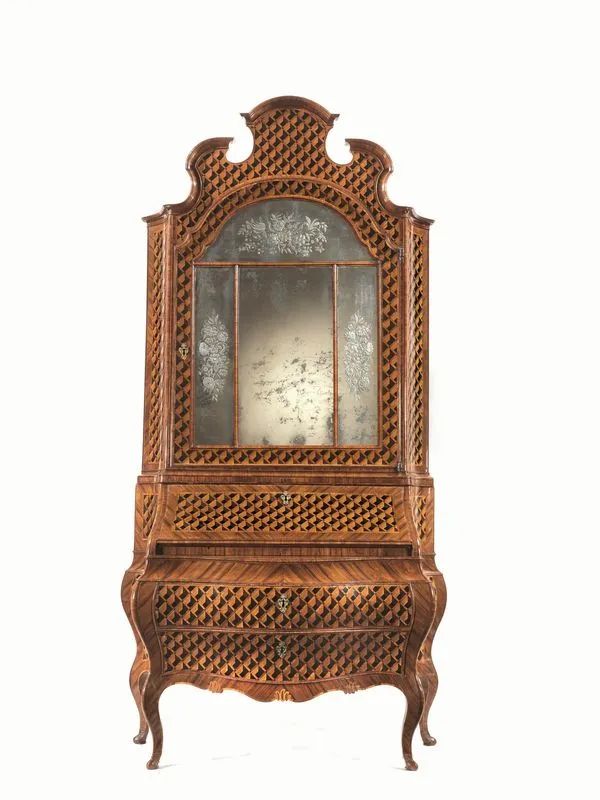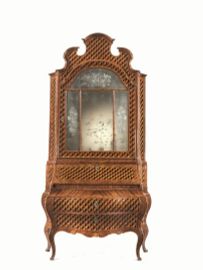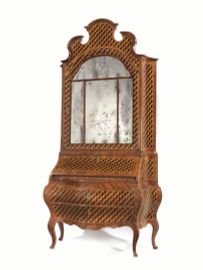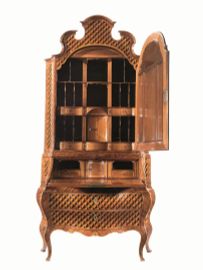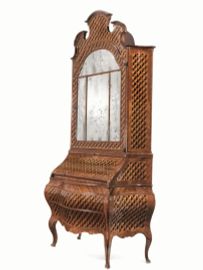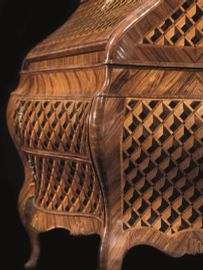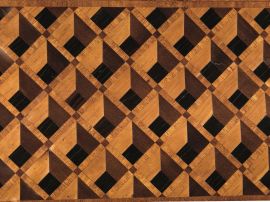COMÒ A RIBALTA CON ALZATA, VENEZIA, 1750 CIRCA
lastronato in legno di noce, acero, mogano, palissandro e bois de rose, decorato a marqueterie geometrica; alzata con specchio inciso a motivi floreali.
Cm 272x140x65.
A VENETIAN BUREAU CABINET, CIRCA 1750
veneered in walnut, maple-wood, mahogany and rosewood, decorated with geometric marquetry; the upper section, with a mirror engraved with floral motifs.
272x140x65 cm
Provenienza
Collezione privata, Modena
Il ritmo dolce e serrato delle curve, le raffinate profilature in bois de rose nonché il leggiadro decoro a marqueterie geometrica caratterizzano questo straordinario esemplare di trumò veneziano.
Il termine veneziano burò-trumò si ispira alle parole francesi bureau e trumeau e sta a indicare un mobile-scrivania con alzata a specchio, arredo di gran pregio costruito sempre con estrema sapienza e abile scelta di legni.
È il caso del nostro mobile che, come quasi sempre accade nella mobilia della Serenissima, presenta una struttura in legno dolce d’abete rivestita da una preziosa lastronatura di legni pregiati come il noce, l’acero, il mogano e il palissandro, oltre a legni di frutto e al bois de rose.
Il superbo intarsio e il contrasto dei materiali utilizzati regalano trame policrome con un incisivo effetto volumetrico, con risultati simili a quelli che troviamo sui mobili eseguiti da grandi ebanisti francesi come Jean-François Oeben, famoso per la sua maestria in questo tipo di intarsio.
Pur mantenendo la struttura architettonica inalterata fino al neoclassicismo, il nostro arredo mostra di adeguarsi perfettamente ai dettami della moda di metà Settecento, modulando il fronte e i fianchi con dolci curve, smussando gli spigoli e alleggerendosi nei raffinati piedi en cabriole e nelle fini rocailles intarsiate sul grembiule sagomato.
Non sfugge a questa logica costruttiva di curve e controcurve neppure la calatoia che si apre su una base a due cassetti, scoprendo uno scarabattolo con due cassettini e altrettanti vani centrati da uno piccolo sportello, anch’essi mossi.
L’alzata presenta un’anta con specchio al mercurio inciso a motivi floreali, che segue le linee ondulate del mobile e termina con un cappello realizzato con legno di testa e spezzato in tre moduli curvilinei. Al suo interno nasconde due file di cassetti intervallati da un’anta centrale e piccoli vani a giorno, spesso destinati ad accogliere preziose porcellane.
La inusuale e raffinata decorazione a marqueterie geometrica di questo trumò fa pensare a una committenza straniera, forse un rampollo di una nobile famiglia austriaca o francese o a un uomo d’affari inglese, personaggi che durante il XVIII secolo si trasferirono a vivere nella laguna veneziana.
Un comò della stessa manifattura è pubblicato su C. Santini, Mille mobili veneti, Modena 2002, vol. III, tavv. 112-113 (fig. 1); un altro è pubblicato su S. Levy, Il Mobile Veneziano Del Settecento, vol. I, Milano 1964, tav. 107 (fig.2)
Bibliografia di confronto
S. Levy, Il Mobile Veneziano del Settecento, vol. I, Milano 1964;
C. Santini, Mille mobili veneti, vol. III, Modena 2002.
The gentle, uninterrupted rhythm of the curves, the refined rosewood borders and the elegant geometric marquetry decoration characterize this extraordinary example of Venetian trumeau.
The Venetian term “burò-trumò” is inspired by the French words bureau and trumeau and defines a piece of furniture composed of a desk and an upper section with a mirror, invariably created with great expertise and with an adroit choice of woods.
This is the case of our piece of furniture, which shows a fir wood frame veneered with panels of precious woods, such as walnut, maple-wood and mahogany, besides fruitwood and rosewood, as is common with almost all the furniture from the Serenissima.
The superb inlay work and the contrast between the different materials create polychromed designs with an incisive volumetric effect, obtaining results similar to those in pieces of furniture by important French cabinet-makers such as Jean-François Oeben, famous for his skills in this kind of marquetry.
Though the architectural structure of these objects remained unchanged until Neoclassicism, our trumeau adapts perfectly to the dictates of fashion of the mid-18th century, gently curving the front and the sides, rounding the corners and becoming lighter in the elegant cabriole legs and in the refined engraved rocaille decoration of the waved apron.
This structure of curves and counter-curves also embraces the fall-front that opens above a base with two drawers, concealing an interior “scarabattolo” with a small central door with two small drawers and two pigeon holes, also waved, on either side.
The upper section shows a door with a mercury mirror engraved with floral motifs, and follows the waved outline of the trumeau, ending with an end grain wood broken arched cornice. It conceals a central door, two rows of drawers and small folio compartments and pigeon holes, which were often used to contain precious pieces of porcelain.
The unusual and elegant geometric marquetry decoration of this bureau cabinet may reveal the presence of a foreign patron, maybe the descendant of a noble Austrian or French family or an English businessman, prominent figures who moved to the Venetian lagoon during the 18th century.
A bureau of the same manifacture is published in C. Santini, Mille mobili veneti, Modena 2002, vol. III, pls. 112-113 (fig. 1); another is published in S. Levy, Il Mobile Veneziano Del Settecento, vol. I, Milano 1964, pl. 107.
Comparative literature
S. Levy, Il Mobile Veneziano del Settecento, vol. I, Milano 1964;
C. Santini, Mille mobili veneti, vol. III, Modena 2002.

